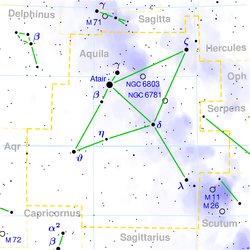- Theta Aquilae
-
θ Aquilae Observation data
Epoch J2000 Equinox J2000Constellation Aquila Right ascension 20h 11m 18.2855s Declination -00° 49′ 17.26″ Apparent magnitude (V) 3.242 Characteristics Spectral type B9.5III U−B color index -0.14 B−V color index -0.07 Astrometry Radial velocity (Rv) -27.3 km/s Proper motion (μ) RA: 35.48 mas/yr
Dec.: 6.05 mas/yrParallax (π) 11.36 ± 0.92 mas Distance 290 ± 20 ly
(88 ± 7 pc)Absolute magnitude (MV) -1.48 Details Mass 3.7 M☉ Radius 5.5 R☉ Luminosity 370 L☉ Temperature 10,800 K Rotation 63 km/s Other designations Database references SIMBAD data Database references SIMBAD data Theta Aquilae (θ Aql, θ Aquilae) is a binary star in the constellation Aquila. It is approximately 287 light years from Earth. It has the traditional name Tseen Foo, which is derived from the Mandarin 天桴 tiānfú meaning "the heavenly raft(er)"; it may also mean drumsticks, with Altair, Beta Aquilae and Gamma Aquilae being the drum.
In Chinese, 天桴 (Tiān Fú), meaning Celestial Drumstick, refers to an asterism consisting of θ Aquilae, 62 Aquilae, 58 Aquilae and η Aquilae.[1] Consequently, θ Aquilae itself is known as 天桴一 (Tiān Fú yī, English: the First Star of Celestial Drumstrick.)[2]
In the catalogue of stars in the Calendarium of Al Achsasi al Mouakket, this star was designated Thanih Ras al Akab (تاني ألرأس ألعقاب - taanii al ra’s alʕuqāb), which was translated into Latin as Secunda Capitis Vulturis, meaning the second (star) of eagle's head.[3]
This star, along with δ Aql (Denebokab) and η Aql, were Al Mizān (ألميزان), the Scale-beam.[4]. According to the catalogue of stars in the Technical Memorandum 33-507 - A Reduced Star Catalog Containing 537 Named Stars, Al Mizān were the title for three stars :δ Aql as Al Mizān I, η Aql as l Mizān II and θ Aql as Al Mizān III[5]
Structure
Theta Aquilae is a spectroscopic binary classified as a blue-white B-type giant with an apparent magnitude of +3.24. The binary has an orbital period of 17.123 days.
References
- ^ (Chinese) 中國星座神話, written by 陳久金. Published by 台灣書房出版有限公司, 2005, ISBN 9789867332257.
- ^ (Chinese) AEEA (Activities of Exhibition and Education in Astronomy) 天文教育資訊網 2006 年 7 月 3 日
- ^ Knobel, E. B. (June 1895). "Al Achsasi Al Mouakket, on a catalogue of stars in the Calendarium of Mohammad Al Achsasi Al Mouakket". Monthly Notices of the Royal Astronomical Society 55: 429. Bibcode 1895MNRAS..55..429K.
- ^ Allen, R. H. (1963). Star Names: Their Lore and Meaning (Reprint ed.). New York: Dover Publications Inc. p. 61. ISBN 0486210790. http://penelope.uchicago.edu/Thayer/E/Gazetteer/Topics/astronomy/_Texts/secondary/ALLSTA/Aquila*.html. Retrieved 2010-12-12.
- ^ Jack W. Rhoads - Technical Memorandum 33-507-A Reduced Star Catalog Containing 537 Named Stars, Jet Propulsion Laboratory, California Institute of Technology; November 15, 1971
Stars of Aquila Bayer Flamsteed - 4
- 5
- 7
- 8
- 10
- 11
- 12 (i)
- 13 (ε)
- 14 (g)
- 15 (h)
- 16 (λ)
- 17 (ζ, Deneb el Okab)
- 18
- 19
- 20
- 21
- 22
- 23
- 24
- 25 (ω¹)
- 26 (f)
- 27 (d)
- 28 (A)
- 29 (ω²)
- 30 (δ)
- 31 (b)
- 32 (ν)
- 35 (c)
- 36 (e)
- 37
- 38 (μ)
- 39 (κ)
- 41 (ι, Al Thalimain)
- 42
- 44 (σ)
- 45
- 46
- 47 (χ)
- 48 (ψ)
- 49 (υ)
- 50 (γ, Tarazed)
- 51
- 52 (π)
- 53 (α, Altair)
- 54 (ο)
- 55 (η)
- 56
- 57
- 58
- 59 (ξ)
- 60 (β, Alshain)
- 61 (φ)
- 62
- 63 (τ)
- 64
- 65 (θ, Tseen Foo)
- 66
- 67 (ρ) (till 1992)
- 68
- 69
- 70
- 71 (l)
- 14 Sge
- 62 Ser

This binary or multiple star system-related article is a stub. You can help Wikipedia by expanding it.

